How does ecological function correspond to morphology in coregonines from Lakes Superior, Michigan, and Huron?
Contributing Authors
David Bunnell (USGS, dbunnell@usgs.gov), Jake Vander Zanden (University of Wisconsin-Madison), Ben Martin (University of Wisconsin-Madison)
Project Description
Fish managers recognize the value of diversity, within species and within communities, but most are focused on how diversity translates to function within the food web. For example, how does the diet of lake whitefish (Coregonus clupeaformis) differ from that of cisco (C. artedi), or how much trophic overlap exists between ciscoes and non-native planktivores (e.g., rainbow smelt, alewife), or between different forms of ciscoes? One common ecological hypothesis is that form is related to function (Keast and Webb 1966). For example, a fish with a sub-terminal mouth and short gill rakers is more likely to be a benthic forager, while a fish with a terminal mouth and longer gill rakers is more likely to be a pelagic forager. If this hypothesis holds for coregonines, then a related question is can genetic markers for form be identified?
Coregonines are an important assemblage of planktivores, benthivores, and piscivores within the Great Lakes. Managers have committed to restoring extirpated populations and increasing the abundance of populations in decline. Coregonines pose several challenges to taxonomy, including limited genetic differentiation and to an untrained eye similar morphology. Recently, coregonine genetic and morphological research has been re-invigorated using genomics and geometric approaches, respectively. But less work has been conducted on functional ecology of coregonines, even though the Department of Interior Coregonid Restoration framework calls for the use of ecology, morphology, and genetics to discriminate populations and resolve taxonomy.
We propose to use a new cutting-edge method, amino-acid specific nitrogen isotopes (AASN), to describe the trophic position of coregonids and other key species within the food-web, across multiple lakes. This method resolves shortfalls in previous methods because it does not require baseline information from a given lake or embayment thereby facilitating comparisons of trophic structure across systems and through time. Blanke et al. (2018) recently demonstrated this technique for deepwater ciscoes (and alewife and rainbow smelt) in Lakes Superior and Michigan, revealing consistent trophic position among deepwater ciscoes (C. nigripinnis, C. hoyi, C. kiyi, C. zenithicus, and C. reighardi) in the historical food webs. The conserved nature of trophic positions between lakes suggests that the morphology for a given species affects its trophic niche. In an exploratory analysis between historical trophic position (Blanke et al. 2018) and morphology reported by Koelz in Eshenroder et al. (2016), trophic position was negatively related to pectoral and dorsal fin length (i.e., feeding at higher trophic levels was associated with larger fins). Perhaps short-finned coregonines like C. reighardi, C. zenithicus, and C. artedi are more pelagic oriented and feed more on zooplankton than larger-finned coregonids which are more associated with the bottom and feed more on mysids or Diporeia spp. However, a more-refined analysis using size-corrected data that eliminates allometric noise associated with ratios is needed.
Our proposed work will leverage historical data from Blanke et al. (2018). Specifically, we propose to add Lake Huron (both historical and contemporary) and several key species, including C. artedi, C. clupeaformis, lake trout, and Mysis. Furthermore, we propose to collect morphological information (and provide genetic information to Stott to analyze in her proposal entitled “Genetic diversity among Great Lakes cisco species: exploring taxonomic and population boundaries) on the same fish that AASN will be analyzed. Our emphasis will be on data collection in year 1, and then data synthesis (across genetics, morphology, and function) in year 2 (not included in this budget). Improving understanding of these linkages for coregonines and resolving the remaining taxonomic uncertainty (e.g., delineation of C. artedi populations) is a fundamental requirement for coregonine restoration.
Comparison of traditional and geometric morphometrics using Lake Huron ciscoes of the Coregonus artedi complex | Transactions of the American Fisheries Society
Past, Present and Future Ciscoes: Wisconsin Sea Grant research | Wisconsin Sea Grant
Comparison of size-corrected traditional & geometric morphometrics for separating coregonine forms | New York AFS
